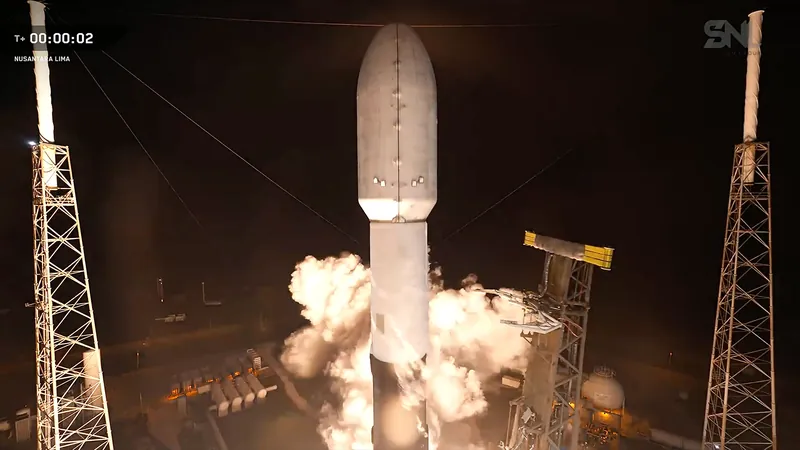
Sky is the Limit: SpaceX Sends Nusantara Lima Satellite to Boost Indonesia's Connectivity
2025-09-12
Author: Sarah
In a spectacular showcase of technological prowess, SpaceX lit up the night sky on September 11, 2025, launching the Nusantara Lima satellite into orbit for Indonesian telecom giant PT Pasifik Satelit Nusantara (PSN). This bold mission promises to revolutionize connectivity across Indonesia's vast archipelago.
Liftoff occurred at 9:56 p.m. EDT from Cape Canaveral Space Force Station in Florida, following a three-day weather delay. The Falcon 9 rocket soared into the atmosphere with precision, marking yet another milestone in SpaceX's ambitious launch schedule.
Just 8.5 minutes post-launch, the rocket's first stage successfully returned to Earth, landing on the SpaceX drone ship "A Shortfall of Gravitas" stationed in the Atlantic. This particular booster, designated 1078, is now a seasoned veteran with 23 successful flights under its belt, closing in on SpaceX's reflight record.
As the Falcon 9's upper stage carried the Nusantara Lima satellite further into space, it was deployed into geosynchronous transfer orbit a mere 27.5 minutes after takeoff. Built by Boeing, this state-of-the-art satellite will orbit approximately 22,236 miles above Earth, perfectly synchronized with the planet’s rotation, allowing it to "hover" over specific areas—a configuration ideal for communication, weather monitoring, and reconnaissance.
Set to begin operations in 2026, Nusantara Lima promises to serve Indonesia's 17,000 islands and surrounding regions, significantly boosting internet and telecommunications capabilities. "Indonesia was one of the pioneers in satellite communications, and Nusantara Lima continues this tradition," expressed Adi Rahman Adiwoso, CEO of PSN Group. He highlighted that the satellite's impressive capacity of over 160 Gbps will empower communities and local businesses, enhancing access to reliable services previously out of reach.
This launch marks the 114th Falcon 9 mission of the year, with over 70% of SpaceX's flights dedicated to expanding its Starlink constellation, which now boasts over 8,300 operational satellites. As technology advances, SpaceX continues to connect the world, one launch at a time.


 Brasil (PT)
Brasil (PT)
 Canada (EN)
Canada (EN)
 Chile (ES)
Chile (ES)
 Česko (CS)
Česko (CS)
 대한민국 (KO)
대한민국 (KO)
 España (ES)
España (ES)
 France (FR)
France (FR)
 Hong Kong (EN)
Hong Kong (EN)
 Italia (IT)
Italia (IT)
 日本 (JA)
日本 (JA)
 Magyarország (HU)
Magyarország (HU)
 Norge (NO)
Norge (NO)
 Polska (PL)
Polska (PL)
 Schweiz (DE)
Schweiz (DE)
 Singapore (EN)
Singapore (EN)
 Sverige (SV)
Sverige (SV)
 Suomi (FI)
Suomi (FI)
 Türkiye (TR)
Türkiye (TR)
 الإمارات العربية المتحدة (AR)
الإمارات العربية المتحدة (AR)